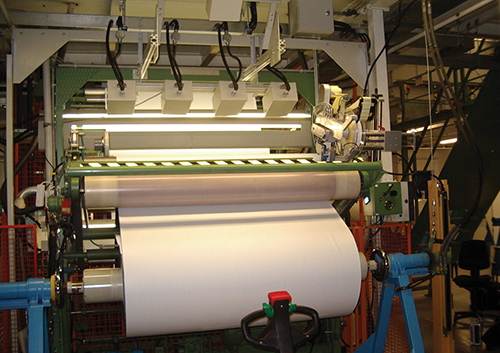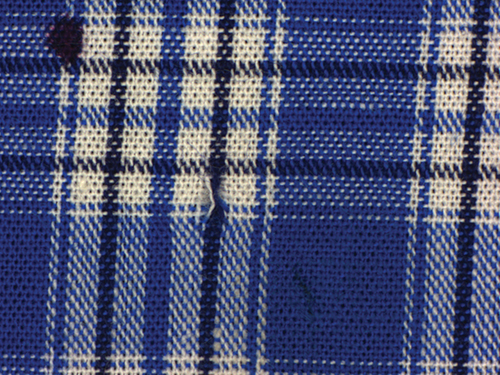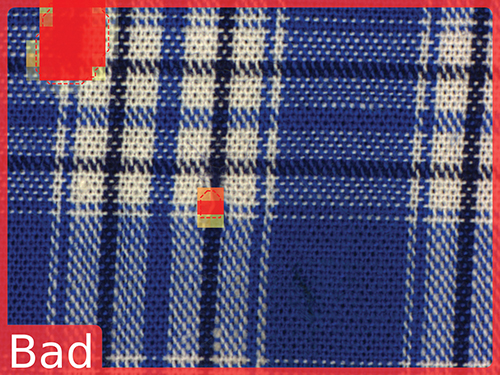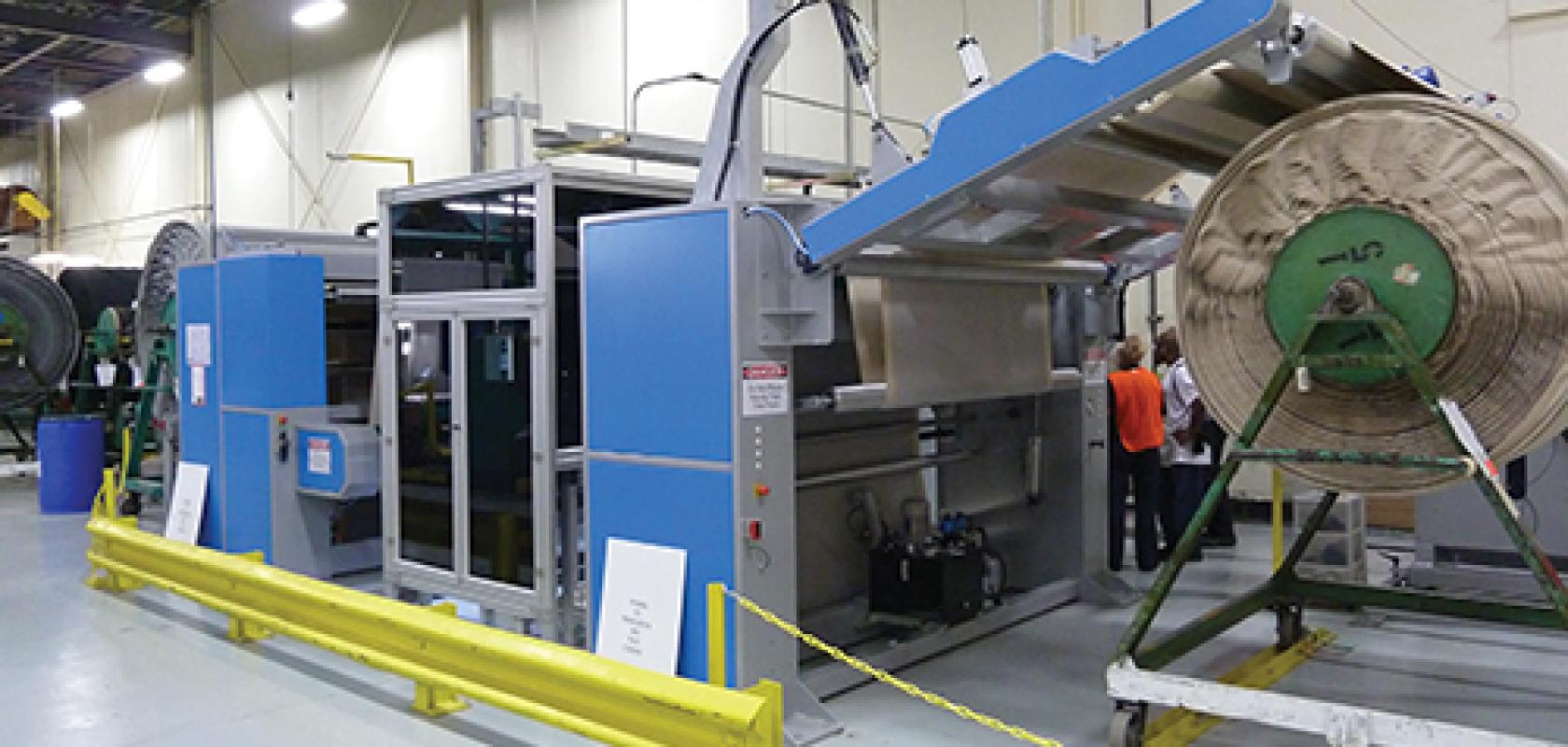Inherent variability in fabrics is one defining feature of textile inspection. Different yarns and patterns, as well as dyes or other post-forming processes, all add to a web of material where it is incredibly difficult for an automated vision system to tell the difference between a defect and a naturally occurring variation. To give an example, UK-based Shelton Machines Limited – also known as Shelton Vision – supplied an inspection system to a company laminating fabric for performance sportswear and waterproof outerwear, which processed around 6,000 types of product a year. The material mainly consists of three layers: a woven fabric outer layer with a PTFE membrane and a liner on the inside. The combination of the three layers, along with different colours, different styles and so on, gives 6,000 product varieties.
‘It would be impossible to do that [inspect] manually for that amount of products within a reasonable time,’ commented Mark Shelton, managing director of Shelton Vision ‘The high turnover and wide range of products is typical of textiles.’
Each variety of laminated fabric was trained on Shelton Vision’s inspection system. The company developed a way of automating the training of its vision software, so that the first time the system sees a new product it realises that the fabric is not in its database and will initiate automated training.
Machine vision holds a lot of promise for quality assurance in textile production if system builders can overcome the hurdles involved in inspection, for which product variation is only one.
The first place where a vision system might be used is on the machine on which the fabric is formed, so a loom or a knitting machine. ‘There might be 200 to 400 looms, or more, in a factory, so to put a vision system on each of those is restrictive, in terms of cost,’ commented Shelton. ‘You need very low hardware costs in order to do this, although things are moving in that direction and it’s something Shelton Vision is actively working on, and has delivered a number of systems.’
Image acquisition from a camera installed on a loom though is difficult, according to Olivier Despont, business development at Swiss vision software firm Vidi Systems, because of the vibrations from the machine. Vidi Systems is in discussion with companies for field deployment of its image analysis software in textile inspection, including a couple of machine builders for inspecting on the loom, although Despont said this will more likely be a long-term project because there first needs to be a camera system that deals with vibration. Vidi Systems has carried out feasibility tests for inspecting narrow fabrics, such as harnesses and security belts.
The alternative to installing cameras on the loom is to have a standalone inspection unit, a more common option. In weaving in particular, it’s possible to mend defects, so the raw fabric could potentially be run through a high-speed inspection system offline, to decide which defects are worth repairing. According to Shelton, in general, 90 per cent of the value of the fabric is the raw material.
Once the fabric is formed it is then dyed, finished, heat set, or coated before it’s used for its final purpose. ‘Each of those processes adds value, so it’s worth inspecting either during the process if you can stop the machine once a defect is detected, or before the fabric goes into the next process stage, so value is not added to something that’s already defective,’ explained Shelton.
He gave the example of laminating car headliner fabric, priced at around £1 a metre, to foam at around £3 a metre. ‘If you start laminating good foam to bad fabric, you’re very quickly wasting a lot of money,’ he said.
Roughly speaking, Shelton said that a textile factory with 200 looms will have around 20 dying machines, three heat setting machines, and then one or two automatic high-speed fabric inspection systems. The same factory operating manual inspection would have around 15 manual inspection stations, manned at least 16 or 17 hours a day. The effective throughput speed for manual inspection varies between 5 to 12 metres per minute, according to Shelton, whereas a vision system operating at the end of a final process like heat setting might run at 50 to 60 metres per minute. Shelton Vision can provide a purpose-built high-speed roll-to-roll inspection machine capable of operating well above 100 metres per minute for textiles, and double that for simpler products.

There might be five or six different illumination setups for inspecting textiles
Shelton Vision might use five or six different illumination setups for inspecting apparel textiles: top light or diffuse lighting; transmitted light; light that is shining at a low angle across the fabric and light at a low angle shining down the length of the fabric; and reflective illumination. There might also be cameras looking at the underside of the web. The number of cameras used depends on the minimum defect size. ‘We’re building a system at the moment with a field of view of 5.8 metres running at 120 metres per minute,’ Shelton said.
Vidi Systems is targeting textile inspection, among other areas, with its image analysis software, which is based on deep learning techniques that are able to learn what constitutes a pass or a fail as the system acquires more data. This is compared to traditional machine vision software which is rule-based – the inspection task is broken up into a succession of filters and small logical steps and then translated into computer code. Standard vision software libraries can find it difficult to tolerate the variation seen in textile production, such as that generated by the web flexing and bending giving curved or squeezed patterns. Vidi Systems’ software, however, can mimic the human brain’s capacity to learn the normal appearance of the web, including those natural variations, and at the same time highlight anomalies that matter, according to Despont. Instead of programming a computer, the software learns by showing the system good samples.
With a high-end GPU, a model of a new textile can be trained in about two minutes, Despont said. Then, in production, the system can analyse up to 15 megapixels per second and deal with any type of image resolution and size. ‘The image analysis tool can be applied to any type of fabric,’ he added. ‘It has a built-in classifier that can learn to distinguish multiple types of product on the same machine, while still finding any anomalies that can appear – it is very versatile.’
Shelton Vision’s software also includes an automatic training functionality to deal with new styles of fabric, as well as being able to classify and grade defects to distinguish between a subtle defect and a normal variation in the fabric. It also has a way of validating the system by running a video of the defect map, as if the system were inspecting the fabric again in order to tune the algorithm sensitivity.
Return on investment
One of the big returns on investment for a vision system, according to Shelton, is in optimising the process of portioning the fabric into smaller rolls, or pieces, that are then packaged and sold. Shelton Vision’s inspection system will generate an electronic defect map, an interactive map for the full width and length of the web with positions and types of defects marked. This is then reviewed for commercial sensitivity. ‘Even though the vision system can be very accurate, textile manufacturers operate in a commercial world, where sometimes they have some discretion – with agreement from their customers – to ship outside of agreed tolerances,’ commented Shelton.
Following review, Shelton Vision’s software optimises the process of cutting a 5,000-metre roll of fabric into 100-metre long rolls, which is the unit of sale. The software will take the rule set for a particular product – Shelton said a rule set might be something like: maximum roll length of 100 metres; minimum roll length 70 metres; seven defects per 100 metres quality level; two metres at each end without any defects; one seam per roll allowed – the software takes all those rules and calculates the best way to cut the fabric to get maximum yield or maximum quality. ‘It will give a predictive cutting plan and it will tell you a percentage yield,’ Shelton remarked. ‘The customer might then run a second cut plan with tolerances on the rules to get a plan with slightly higher percentage yield.’


Vidi Systems' deep learning image analysis learns between natural variation and defects
Once the manufacturer is happy with the cut plan, the fabric goes back into modified re-rolling machines where the operator synchronises the map with the fabric. The machine is then automatically stopped at each action point by Shelton Vision WebViewer control software, which might be to mark a defect or finish a roll or take a sample.
‘One of the key things in this process is to maintain the synchronisation, because virtually all fabric has some sort of elasticity,’ Shelton observed. ‘We have a means of maintaining and adjusting for the stretch factor within the fabric, so that whenever we stop the machine we’re stopping the web at the right calculated position.
‘Let’s say you improve the yield by one per cent by putting this sequence of inspection, review, optimisation and controlled cutting in place, which is pretty much a given,’ he continued. ‘If you had a turnover of $100 million and you save one per cent, you just put $1 million straight onto the bottom line.’
Shelton compares this automated process with manual inspection, where the final rolls are measured and cut by the operator on an inspection table. The operator might cut the first roll of 100 metres, start on the second roll and after seven metres there’s a seam or a big defect that has to be removed – that seven metres of fabric is too short to ship and so is wasted. ‘Most customers will have minimum piece length in their rules,’ Shelton explained. ‘If the inspector had known the defect was at 107 metres, they could have made two shorter rolls that would still comply with the rules of the customer and save the seven metres. That’s a fairly gross example of how you can lose a lot of fabric because you don’t know what’s coming through.
‘This is the biggest return on investment for a vision system,’ he continued. ‘You also get a lot of data that allows you to improve the processes. If you can avoid defects, that’s also a big win, and if you can trace the defects back to the source you can address some of the problems causing them. The easiest two calculations are labour saved and the yield improvement through optimisation.’
Improved customer relations is another area where a vision system can help, according to Shelton. ‘If the manufacturer is getting a lot of claims every month it can be very expensive, because very often it has to resupply at no extra cost,’ he said. ‘The hidden costs of not getting it right first time on delivery are significant. People don’t realise how much fabric is flown around the world to try and catch up in the production process if a faulty roll of fabric
is supplied.
‘Many companies have attempted to make vision systems for textile applications,’ he added. ‘It’s a challenging area of varied applications where detecting too much is almost as bad as not detecting everything that should be found. A system that picks up too many false alarms is likely to be ignored.’
In general, the textile sector, certainly for automotive textiles, is becoming more automated, according to Shelton. ‘If automotive customers are going to award contracts for interior fabrics they will insist on some level of automation in terms of inspection.’
In other areas of textile production there is a strong desire for this technology. Growth areas outside Europe are India and North America, Shelton said. ‘There has been a surge of interest from companies within lower labour-cost countries, where the desire to increase capacity with automation is very strong. They have some very large and sophisticated businesses, and they are really keen on expanding their capacity by incorporating new technology, rather than doubling the number of people they’ve got inspecting the fabric.’


